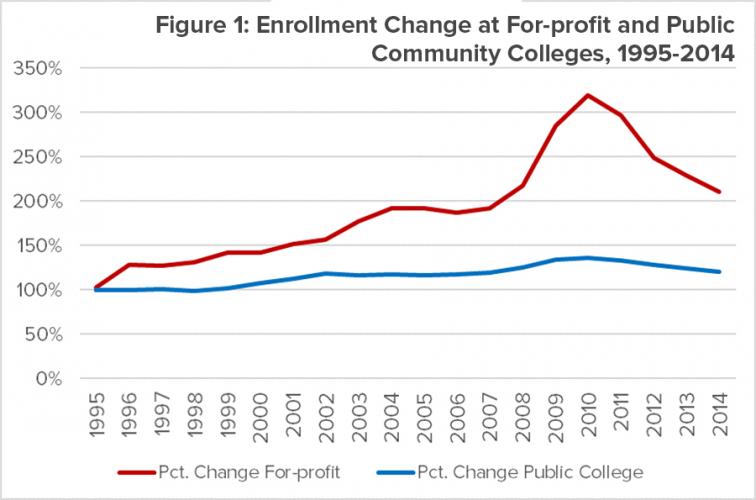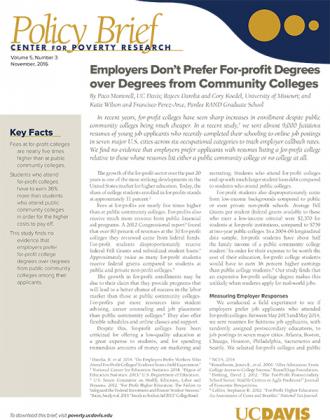Employers Don’t Prefer For-profit Degrees over Degrees from Community Colleges
By Paco Martorell, UC Davis; Rajeev Darolia and Cory Koedel, University of Missouri; and Katie Wilson and Francisco Perez-Arce, Pardee RAND Graduate School
In recent years, for-profit colleges have seen sharp increases in enrollment despite public community colleges being much cheaper. In a recent study,[1] we sent almost 9,000 fictitious resumes of young job applicants who recently completed their schooling to online job postings in seven major U.S. cities across six occupational categories to track employer callback rates. We find no evidence that employers prefer applicants with resumes listing a for-profit college relative to those whose resumes list either a public community college or no college at all.
The growth of the for-profit sector over the past 20 years is one of the most striking developments in the United States market for higher education. Today, the share of college students enrolled in for-profits stands at approximately 11 percent.[2]
Key Facts
- About 29% of workers from 2004-07 — before the Great Recession began — reported that their “hours vary” for at least a four-month period. This percentage increased to almost 40% among workers from 2008-13.
- Across both periods, workers who reported inconsistent work hours earned 15-20% less weekly than those reporting stable schedules. They were also 30-45% more likely to be in poverty.
- Before and after the Great Recession, workers who belonged to a labor union or lived in a state with higher-than-average rates of union membership were 2% less likely to have work schedules that changed from week to week.
Fees at for-profits are nearly five times higher than at public community colleges. For-profits also receive much more revenue from public financial aid programs. A 2012 Congressional report[3] found that over 80 percent of revenues at the 30 for-profit colleges they reviewed came from federal funds. For-profit students disproportionately receive federal Pell Grants and subsidized student loans.[4] Approximately twice as many for-profit students receive federal grants compared to students at public and private non-profit colleges.[5]
The growth in for-profit enrollments may be due to their claim that they provide programs that will lead to a better chance of success in the labor market than those at public community colleges. For-profits put more resources into student advising, career counseling and job placement than public community colleges.[6] They also offer flexible schedules and online classes and support.
Despite this, for-profit colleges have been criticized for offering a low-quality education at a great expense to students, and for spending tremendous amounts of money on marketing and recruiting. Students who attend for-profit colleges end up with much larger student loan debt compared to students who attend public colleges.
For-profit students also disproportionately come from low-income backgrounds compared to public or even private non-profit schools. Average Pell Grants per student (federal grants available to those who meet a low-income criteria) were $2,370 for students at for-profit institutions, compared to $759 at two-year public colleges.
In a 2004-09 longitudinal data sample, for-profit students have about half the family income of a public community college student.[7] In order for their expense to be worth the cost of their education, for-profit college students would have to earn 36 percent higher earnings than public college students.[8] Our study finds that an expensive for-profit college degree makes this unlikely when students apply for real-world jobs.
Measuring Employer Responses
We conducted a field experiment to see if employers prefer job applicants who attended for-profit colleges. Between May 2013 and May 2014, we sent resumes for fictitious job applicants, with randomly assigned postsecondary educations, to job postings in seven major cities: Atlanta, Boston, Chicago, Houston, Philadelphia, Sacramento and Seattle. We selected for-profit colleges and public community colleges that were local to each city. We had 8,914 resumes in our analytic sample.
Jobs included administrative assisting, customer service, information technology, medical assisting (excluding nursing), medical billing/office and sales. The resumes included entry level jobs and low skilled jobs. All of the resumes were sent to jobs for which the fictional applicant would be qualified. The overall response rate was 11.4 percent. Of all applicants, 4.9 percent received an interview request.
While our main comparison was responses to for-profit and public community college degrees, we also compared responses to resumes that did not listing a postsecondary education at all. The work history listed in the applicants’ resumes reflected real resumes posted by those applying to jobs online. Some of our fictional resumes also included work history gaps to reflect real applicants. The resumes also included a variety of names suggesting different genders and ethnicities.
Insignificant Differences in Call-backs
Controlling for all variables not related to educational experience—including city, industry, suggested gender, ethnicity and other external factors—we find no indication that listing a for-profit college increases employer interest compared with listing a public community college.
In fact, all point estimates suggest employers prefer applicants from community colleges, though none were statistically significant. We also find no evidence that job applicants benefit from attending a for-profit college compared to high-school graduates listing no post-secondary education. However, the point estimates are all small and statistically insignificant.
We further examined whether resumes listing community colleges elicit more callbacks than resumes listing no college experience. In the employer-response and interview-request models, the estimates of the community college effect are consistently positive but not statistically significant.
Expensive Degrees Show No Advantage
While for-profit college students are more likely to complete a program than their community college counterparts, we find no payoff to completing an associate’s degree compared with having a vocational certificate or not having any certificate or degree. Though our study did not examine other labor market outcomes, such as wages, this finding suggests that attending a for-profit college does not have immediate benefits when new graduates first apply for jobs.
We also find that employers do not have more interest in applicants who list for-profit colleges than applicants who only have a high school diploma. These findings suggest that neither a for-profit or community college degree have a large immediate labor market payoff.
Our findings show no support for the claim that for-profit colleges make about their programs, that they are better suited to prepare individuals to be successful in the labor market. With this is mind, the large amount of funding from tax-payer money to these schools may need to be reconsidered.
Paco Martorell is an Assistant Professor of Education at UC Davis.
Rajeev Darolia is an Assistant Professor of Educational Leadership & Policy Analysis at the University of Missouri Harry S Truman School of Public Affairs.
Cory Koedel is an Associate Professor of Economics and Public Policy University of Missouri.
Katie Wilson is a Ph.D. candidate at the Pardee RAND Graduate School.
Francisco Perez-Arce is an economist and Professor at the Pardee RAND Graduate School, and Director of the Center for Latin America Social Policy.
[1] Darolia, R. et al. 2014. “Do Employers Prefer Workers Who Attend For-Profit Colleges? Evidence from a Field Experiment.”
[2] National Center for Education Statistics 2014. “Digest of Education Statistics: 2013.” U.S. Department of Education.
[3] U.S. Senate Committee on Health, Education, Labor and Pensions. 2012. “For Profit Higher Education: The Failure to Safeguard the Federal Investment and Ensure Student Success.”
[4] Baum, Sandy et al. 2013. “Trends in Student Aid 2013.” College Board.
[5] NCES, 2014
[6] Rosenbaum, James E., et al. 2006. “After Admission: From
College Access to College Success.” Russell Sage Foundation.
[7] Deming, David J. 2012. “The For-Profit Postsecondary School Sector: Nimble Critters or Agile Predators?” Journal of Economic Perspectives.
[8] Cellini, Stephanie R. 2012. “For-Profit Higher Education: An Assessment of Costs and Benefits.” National Tax Journal.
#povertyresearch













